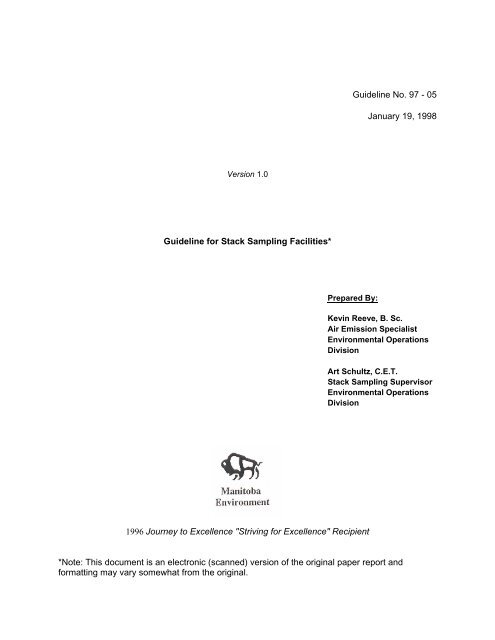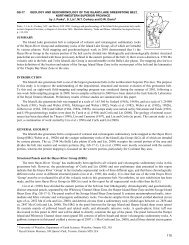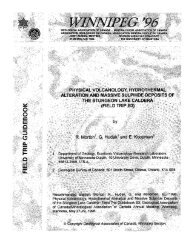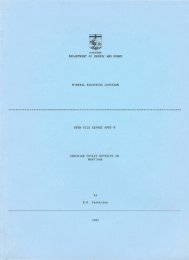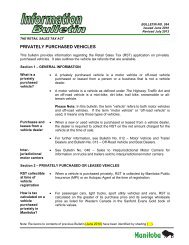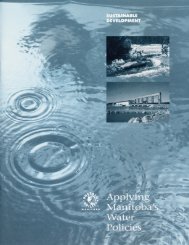Guideline for Stack Sampling Facilities
Guideline for Stack Sampling Facilities
Guideline for Stack Sampling Facilities
Create successful ePaper yourself
Turn your PDF publications into a flip-book with our unique Google optimized e-Paper software.
<strong>Guideline</strong> No. 97 - 05<br />
January 19, 1998<br />
Version 1.0<br />
<strong>Guideline</strong> <strong>for</strong> <strong>Stack</strong> <strong>Sampling</strong> <strong>Facilities</strong>*<br />
Prepared By:<br />
Kevin Reeve, B. Sc.<br />
Air Emission Specialist<br />
Environmental Operations<br />
Division<br />
Art Schultz, C.E.T.<br />
<strong>Stack</strong> <strong>Sampling</strong> Supervisor<br />
Environmental Operations<br />
Division<br />
1996 Journey to Excellence "Striving <strong>for</strong> Excellence" Recipient<br />
*Note: This document is an electronic (scanned) version of the original paper report and<br />
<strong>for</strong>matting may vary somewhat from the original.
<strong>Guideline</strong>s <strong>for</strong> <strong>Stack</strong> <strong>Sampling</strong> <strong>Facilities</strong>, Version 1.0<br />
Manitoba Department of Environment<br />
Page –1-<br />
Preamble<br />
This guideline is intended to provide general guidance only <strong>for</strong> the drafting of specifications <strong>for</strong><br />
stack sampling facilities. As the basic configuration of both stack and method requirements vary<br />
considerably, proponents are encouraged to consult with professional stack sampling<br />
consultants be<strong>for</strong>e any installation occurs. Readers should also note that internal and external<br />
specifications of stack sampling equipment varies between manufacturers. Manitoba<br />
Environment staff may also be contacted by telephone at (204) 945-7100 or by facsimile at<br />
(204) 948-2420.<br />
For specific direction in the application of a stack sampling program, a document titled "<strong>Stack</strong><br />
<strong>Sampling</strong> Per<strong>for</strong>mance Protocol" is available upon request from Manitoba Environment at the<br />
above phone/facsimile numbers.<br />
1. Definitions:<br />
"CEM" means continuous emission monitor;<br />
"monorail" means a supporting device <strong>for</strong> the probe and sample box;<br />
"particulate" means any finely divided liquid or solid matter other than water droplets;<br />
"sample port" means a small opening perpendicular to the stack to provide access to<br />
the gas stream to be sampled;<br />
"snatch block" means a pulley set located in a frame to simplify the lifting of equipment<br />
to the working plat<strong>for</strong>m;<br />
"stack" means a duct, flue, pipe, chimney, vent, opening or other structure through<br />
which contaminants are emitted to the atmosphere;<br />
"stack sampling survey" means a series of stack sampling tests;<br />
"standard conditions" means a temperature of 25 degrees Celsius and a pressure of<br />
760 millimetres of mercury, unless otherwise specified in an Environment Act Licence or<br />
Regulation; and<br />
"working plat<strong>for</strong>m" means scaffolding or permanent walkway required to support<br />
personal and equipment at sample location.
<strong>Guideline</strong>s <strong>for</strong> <strong>Stack</strong> <strong>Sampling</strong> <strong>Facilities</strong>, Version 1.0<br />
Manitoba Department of Environment<br />
Page –2-<br />
2. <strong>Sampling</strong> ports:<br />
a) Ports should normally be made from standard industrial pipe but stainless steel or other<br />
non corroding material should be used where corrosion problems might exist;<br />
b) The inside diameter of all ports should be at least 3 1/2 inches and should extend<br />
outwards from the exterior stack wall a distance of 3 inches. Ports should be flush with<br />
the interior stack wall. Note that some methods, such as EPA Method 201 or 201A,<br />
require a 6 inch diameter port. The proponent should verify the port diameter<br />
requirements pursuant to the applicable method be<strong>for</strong>e installing ports;<br />
c) Ports should be threaded to accommodate screw on caps which should be installed at<br />
the time of port installation. The port caps should be installed whenever the ports are not<br />
in use.<br />
3. Sample port location:<br />
a) Where possible, sample ports should be located at any section of the stack which is eight<br />
or more stack diameters (distance) downstream and two or more stack diameters<br />
(distance) upstream from any flow disturbance such as a bend, constriction, expansion<br />
or stack exit;<br />
Under some circumstances, ports may be located at distances less than the 8 and 2<br />
stack diameters mentioned above, but not less than 4 and 1 stack diameters respectively.<br />
The proponent should note that all stack sampling methods require laminar flow, i.e., no<br />
cyclonic or reverse flow or stratification pattern. Although locating ports at 8 and 2 stack<br />
diameters respectively from a flow disturbance does not guarantee laminar flow,<br />
decreasing the number of stack diameters increases the chance of flow disturbances that<br />
will negatively impact the sampling location, requiring remedial action to either correct the<br />
flow pattern or relocate the sampling ports, etc.<br />
c) For circular stacks with outside diameters less than 3 metres (10 feet) two ports are<br />
normally installed. Ports are installed at identical elevations and 90 degrees or right<br />
angles to each other;<br />
d) For circular stacks with outside diameters greater than 3 metres (10 feet) four ports are<br />
normally required. Ports are installed at identical elevations and 90 degrees or right<br />
angles to each other;
<strong>Guideline</strong>s <strong>for</strong> <strong>Stack</strong> <strong>Sampling</strong> <strong>Facilities</strong>, Version 1.0<br />
Manitoba Department of Environment<br />
Page –3-<br />
e) For rectangular stacks all ports should be placed on one side of the stack at identical<br />
elevations.<br />
f) Ports should be installed at a height which provides clearance <strong>for</strong> the sample box without<br />
interference from the guard rails.<br />
4. Power supply:<br />
a) One, 115 volt, 15 amp. circuit with a grounded two duplex receptacle outlet should be<br />
provided within 7.5 metres (25 feet) of each working plat<strong>for</strong>m;<br />
b) No other equipment should be connected to these circuits;<br />
c) The proponent should contact their stack sampling consultant to ascertain special<br />
electrical requirement <strong>for</strong> CEMs or other analyzers.<br />
5. Monorail Attachment Requirements:<br />
The proponent should contact their stack sampling consultant to ascertain special sampling<br />
equipment attachment requirements. Monorail attachments are necessary <strong>for</strong> each sampling<br />
port of a multi-port configuration. Note that standardization of sampling equipment<br />
attachment does not exist.<br />
6. Work plat<strong>for</strong>m standards:<br />
6.1 Workplace Safety Requirements:<br />
a) The working plat<strong>for</strong>m and access must con<strong>for</strong>m to applicable Workplace Safety and Health<br />
Division Regulations, Building, Electrical and Fire Codes, and all other applicable laws. If a<br />
conflict exists between any Regulations or Codes and the general guidance of this<br />
guideline, the Regulations, Codes and other applicable laws will take precedence.<br />
6.2 Free standing stacks:<br />
a) The work plat<strong>for</strong>m should be constructed of angle iron with an iron grate type working<br />
surface. This plat<strong>for</strong>m should be able to support at least three sampling personnel and 200<br />
pounds of test equipment. A simplified diagram of a typical installation is attached to this<br />
document as Figure 1.
<strong>Guideline</strong>s <strong>for</strong> <strong>Stack</strong> <strong>Sampling</strong> <strong>Facilities</strong>, Version 1.0<br />
Manitoba Department of Environment<br />
Page –4-<br />
b) Where a plat<strong>for</strong>m does not encircle the stack, the plat<strong>for</strong>m should extend 1 metre beyond<br />
each sampling port.<br />
c) The work plat<strong>for</strong>m should serve the entire circumference of a circular stack if sampling<br />
requires four ports.<br />
d) The work plat<strong>for</strong>m <strong>for</strong> rectangular stacks should be placed on the side of the stack where<br />
ports are located.<br />
e) The floor of the plat<strong>for</strong>m should be approximately 1.2 metres (4 feet) below the ports with a<br />
minimum width of 1 metre (3 feet) between stack wall and railing.<br />
f) A guard rail, meeting workplace standards, should be secured to the work plat<strong>for</strong>m. The<br />
guard rail should be designed so that it does not interfere with the sampling train.<br />
g) Safe and easy access to the work plat<strong>for</strong>m should be provided via a permanent ladder<br />
enclosed in a safety cage. No ladder well or other such opening should be located within 1<br />
metre (3 feet) of any port and any opening to the plat<strong>for</strong>m should have a hinged cover at<br />
the plat<strong>for</strong>m.<br />
6.3 Roof top access to stack ports:<br />
a) Approved scaffolding can be used <strong>for</strong> ports located not more than 4.5 metres (15 feet)<br />
above roof level.<br />
b) If a stack is located near the edge of a building roof a guard rail should be provided on the<br />
building roof.<br />
c) If ports are located higher than 4.5 metres (15 feet) above roof level, work plat<strong>for</strong>m<br />
standards <strong>for</strong> free standing stacks apply.<br />
7. Equipment lifting <strong>for</strong> free standing stacks:<br />
a) An extended overhead beam with a winch or provision <strong>for</strong> attaching a snatch block and<br />
rope should be provided at some point beyond the edge of the plat<strong>for</strong>m (above the<br />
walkway). Higher sampling plat<strong>for</strong>ms are usually equipped with a power winch rather than<br />
a manually operated snatch block.
<strong>Guideline</strong>s <strong>for</strong> <strong>Stack</strong> <strong>Sampling</strong> <strong>Facilities</strong>, Version 1.0<br />
Manitoba Department of Environment<br />
Page –5-


